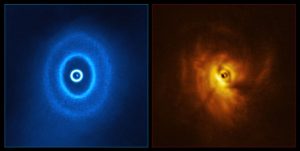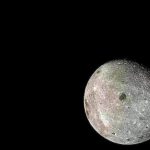Key Takeaways:
- In a discovery, astronomers have identified a system, GW Orionis, featuring three stars encircled by an extraordinary disk of gas and dust.
- Situated approximately 1,300 light-years away in the Orion constellation, this system challenges conventional understanding of planet formation.
- The disk in GW Orionis exhibits three loops, with a distinctive warp in the middle ring and an inner ring at an unusual angle to the others.
- Two competing theories suggest either gravitational forces from the triple-star arrangement or the influence of a nascent planet as the cause for this peculiar disk.
- The enigma of GW Orionis showcases the complexity of cosmic systems and underscores the need for further exploration and technological advancement in astronomy.
Astronomers have unveiled a cosmic ballet featuring three rings of gas and dust orbiting a trio of stars. This mesmerizing display is orchestrated by the star system GW Orionis, which resides a staggering 1,300 light-years away in the Orion constellation.
Within this system, two young stars engage in an intimate celestial waltz, while a third star pirouettes around the pair. Enveloping all three stars is a fragmented disk of dust and gas, a cosmic canvas where future planets may take shape. This disk, unlike the one that gave rise to our solar system’s planets, comprises three loops, each with its unique contortions — a middle ring distinctly warped, and an inner ring playfully askew in relation to its companions.
However, the genesis of GW Orionis and its peculiar disk remains shrouded in mystery, with two groups of astronomers presenting competing narratives. In one account published in Science, astronomer Stefan Kraus and his team propose that gravitational forces and torques arising from the triple-star dance tore apart and deformed the nascent disk. Conversely, a study in the Astrophysical Journal Letters, led by Jiaqing Bi, posits that the disruptive force was a newborn planet.
The question of how such systems form continues to intrigue experts. The galaxy teems with stars that have stellar companions, resulting in planets with orbits akin to a jump rope rather than a smooth revolution around their suns. This misalignment could trace its origins back to the orientation of the birthing disk itself. Nearly a decade ago, astronomers first recognized GW Orionis’ triple-star configuration and its potential planet-forming disk, prompting a fervent pursuit of closer examination.
Through the lenses of the Atacama Large Millimeter/submillimeter Array in Chile, both teams captured the celestial trio: one star about 2.5 times the mass of our sun, another roughly 1.4 times as massive, engaged in a 242-day orbital duet, while a third star of similar mass pirouetted around the inner pair on an 11-year choreography.
Further scrutiny unveiled three distinct rings of dust and gas embracing the stars. The innermost ring nestled approximately 46 times the Earth-sun distance away; the middle, an expansive 185 times that distance; and the outermost, a staggering 340 times the same measurement. To provide context, Neptune is roughly 30 times the Earth-sun distance.
Notably, the innermost ring exhibited a pronounced misalignment with respect to the other rings and the stars. Kraus’ team supplemented their findings with observations from the European Southern Observatory’s Very Large Telescope, which revealed the inner ring’s shadow within the middle loop. This shadow divulged an additional layer of complexity, showcasing the middle ring’s undulating contours.
Subsequently, both research groups turned to computer simulations in pursuit of unraveling the system’s origin story. Here, their conclusions diverged. Bi’s team posits that an as-yet-undiscovered planet, in its infancy, carved out its orbit from the surrounding gas and dust, severing the inner ring from the rest of the disk. Once liberated, the inner ring found its rhythm around the stars, settling into its skewed alignment.

Contrarily, simulations conducted by Kraus’ team suggest that the gravitational tumult induced by the triple stars’ orbital choreography sufficed to dismantle the disk, an event referred to as disk tearing. Each star exerts a gravitational pull, attempting to maintain alignment with the disk, resulting in a cosmic tug-of-war that warped and sheared the disk, further contorting the inner ring. This marks the first observational confirmation of a phenomenon theorized in multiple star systems.
@astroscience26_ Triple #star system warps its #planet-forming disk #universe #space ♬ original sound – Science & Astronomy
This discrepancy hinges on assumptions regarding the disk’s properties, particularly its viscosity, as noted by astrophysicist Nienke van der Marel, a colleague of Bi. While a more viscous disk aligns with Kraus’ proposal, a less viscous counterpart necessitates the presence of a planet to instigate the separation. Nevertheless, current technology lacks the capacity to definitively ascertain the properties of GW Orionis’ disk.
Both research teams grapple with the enigma of what spurred the disk’s division into three distinct rings, leaving this cosmic conundrum far from solved. As Giuseppe Lodato, a theoretical physicist, opines, GW Orionis serves as tangible evidence that the phenomenon of disk tearing is not a mere computational artifact but a genuine cosmic occurrence.
The promise of future telescopes to potentially uncover the elusive planet within this system remains a tantalizing prospect, as noted by van der Marel. The enigma of GW Orionis stands as a testament to the boundless complexities that the cosmos conceals, underscoring the imperative for continued exploration and technological advancement in the field of astronomy.


